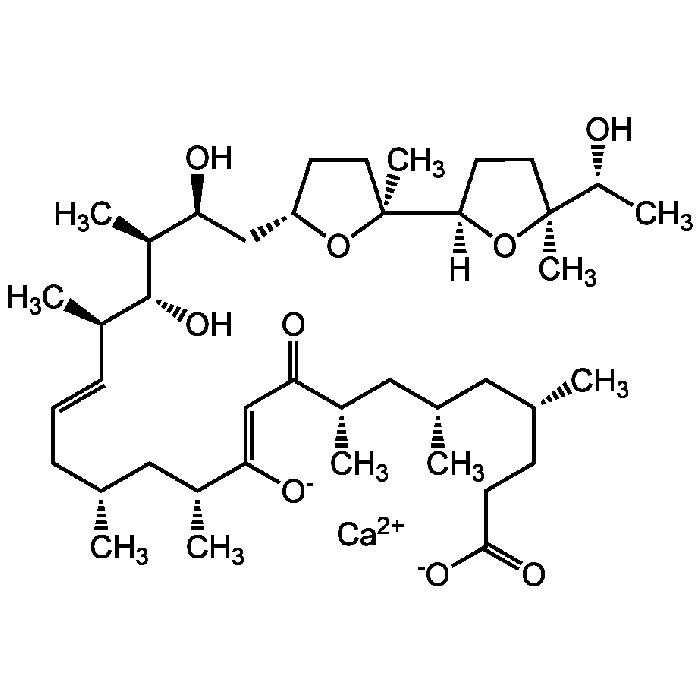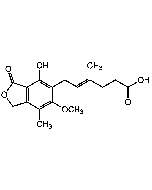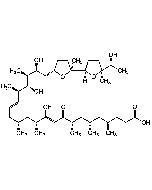Cookie Policy: This site uses cookies to improve your experience. You can find out more about our use of cookies in our Privacy Policy. By continuing to browse this site you agree to our use of cookies.
AdipoGen Life Sciences
Ionomycin . calcium salt
As low as
80
CHF
CHF 80.00
In stock
Only %1 left
AG-CN2-0418-M0011 mgCHF 80.00
AG-CN2-0418-M0055 mgCHF 190.00

| Product Details | |
|---|---|
| Synonyms | Antibiotic SQ 23377; EM 94 |
| Product Type | Chemical |
| Properties | |
| Formula |
C41H70O9 . Ca |
| MW | 707.0 . 40.1 |
| CAS | 56092-82-1 |
| RTECS | NO0650000 |
| Source/Host Chemicals | Isolated from Streptomyces conglobatus. |
| Purity Chemicals | ≥98% (HPLC, TLC) |
| Appearance | White to off-white solid. |
| Solubility | Soluble in DMSO, ethanol or methanol. |
| InChi Key | WKRWUYKLUMMAKG-ZDCQQEHISA-L |
| Smiles | [Ca++].[H][C@@]1(CC[C@](C)(O1)[C@@H](C)O)[C@]1(C)CC[C@@H](C[C@H](O)[C@H](C)[C@H](O)[C@H](C)\C=C\C[C@@H](C)C[C@@H](C)C(\[O-])=C\C(=O)[C@@H](C)C[C@@H](C)C[C@H](C)CCC([O-])=O)O1 |
| Shipping and Handling | |
| Shipping | AMBIENT |
| Short Term Storage | +4°C |
| Long Term Storage | -20°C |
| Handling Advice | Protect from light. |
| Use/Stability | Stable for at least 2 years after receipt when stored at -20°C. |
| Documents | |
| MSDS |
 Download PDF Download PDF |
| Product Specification Sheet | |
| Datasheet |
 Download PDF Download PDF |
Description
- Antibiotic [1].
- Potent and highly selective Ca2+ ionophore. Commonly used to modify intracellular calcium levels to study calcium transport across biological membranes and to calibrate fluorescent Ca2+ indicators [2, 3].
- Ionomycin also transports Pb2+ and some other divalent cations, as well as several lanthanide series trivalent cations at efficiencies that are greater than or equal to those for Ca2+ [3, 9].
- Apoptosis inducer [4, 7]. Induces apoptotic neuronal degeneration in embryonic cortical neurons and cell cycle arrest at G1 phase and induces central demyelination [6].
- Used to stimulate the intracellular production of the cytokines, interferon, perforin, IL-2 and IL-4 usually in conjunction with PMA [5, 8].
- ADAM10 agonist [10].
- Potent inducer of shedding CXCL16 [10].
- TREK-1 channels inhibitor [11].
- PPARγ ligand with a unique binding mode. Shows effective glucose-lowering activity in a mouse model of diabetes [12].
Product References
- Ionomycin, a new polyether antibiotic: W.C. Liu, et al.; J. Antibiot. 31, 815 (1978)
- Characterization of ionomycin as a calcium ionophore: C. Liu & T.E. Hermann; J. Biol. Chem. 253, 5892 (1978)
- Cation transport and specificity of ionomycin. Comparison with ionophore A23187 in rat liver mitochondria: R.F. Kauffman, et al.; J. Biol. Chem. 255, 2735 (1980)
- Ionophore-induced apoptosis: role of DNA fragmentation and calcium fluxes: D.M. Ojcius, et al.; Exp. Cell Res. 197, 43 (1991)
- Contrasting effect of transforming growth factor type beta 1 (TGF-beta 1) on proliferation and interleukin-2 receptor expression in activated and rapidly cycling immature (CD3-CD4-CD8-) thymocytes: A. Dupuy d'Angeac, et al.; J. Cell. Physiol. 154, 44 (1993)
- Ca2+ ionophore-induced apoptosis on cultured embryonic rat cortical neurons: N. Takei & Y. Endo; Brain Res. 652, 65 (1994)
- Differential activation of a calcium-dependent endonuclease in human B lymphocytes. Role in ionomycin-induced apoptosis: K.M. Aagaard-Tillery, et al.; J. Immunol. 155, 3297 (1995)
- Flow cytometric analysis of intracellular IFN-γ, IL-4 and IL-10 in CD3+4+ T-cells from rat spleen: E.M. Caraher, et al.; J. Immunol. Methods 244, 29 (2000)
- The ionophore nigericin transports Pb2+ with high activity and selectivity: a comparison to monensin and ionomycin: S.A. Hamidinia, et al.; Biochemistry 43,15956 (2004)
- Constitutive expression and regulated release of the transmembrane chemokine CXCL16 in human and murine skin: F. Scholz, et al.; J. Invest. Dermatol. 127, 1444 (2007)
- Calcium-dependent inhibition of adrenal TREK-1 channels by angiotensin II and ionomycin: J.J. Enyeart, et al.; Am. J. Physiol. Cell Physiol. 301, C619 (2011)
- Identification of the antibiotic ionomycin as an unexpected peroxisome proliferator-activated receptor γ (PPARγ) ligand with a unique binding mode and effective glucose-lowering activity in a mouse model of diabetes: W. Zheng, et al.; Diabetologia 56, 401 (2013)
- CLCA2 is a positive regulator of store-operated calcium entry and TMEM16A: A. Sharma, et al.; PLoS One 13, e0196512 (2018)
- Mitochondrial DNA Stimulates TLR9-Dependent NET Formation in Primary Graft Dysfunction: B. Mallavia, et al.; Am. J. Respir. Cell Mol. Biol. 62, 364 (2020)







